#this is just mikksys older sister tortures him for multiple paragraphs: the article
Explore tagged Tumblr posts
Text
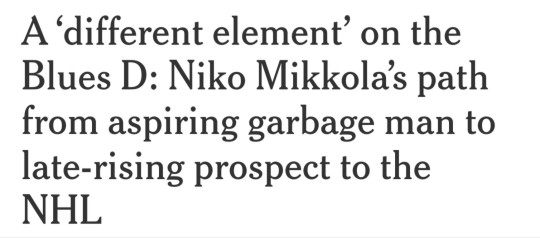
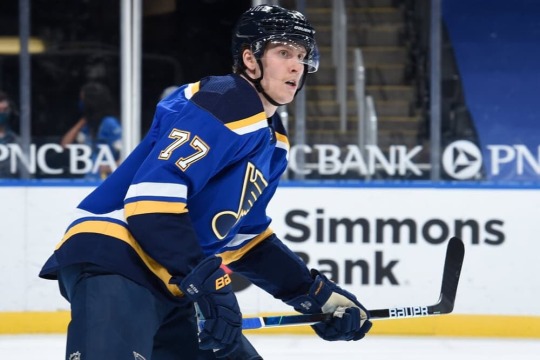
(Top photo of Niko Mikkola: Joe Puetz / Getty Images)
Now that Niko Mikkola is in the NHL, his older sister, Nina Linnainmaa, laughs hysterically when she remembers the story.
As it goes, 20 years ago, the now-24-year-old St. Louis Blues rookie was in daycare in Finland and was asked what he wanted to be when he grew up.
“Ice hockey was always his thing, so he said that he will be an NHL player,” Linnainmaa recalls, bursting between words. “But he had a backup plan, and that was to be the driver for the trash car. You know, those cars that pick the trash from people’s houses? Garbage truck! That seemed like a compelling option. NHL player or drive the garbage truck.”
When Mikkola is told over the phone that Linnainmaa has shared that with a stranger, you can almost hear the 6-foot-4, 185-pound defenseman’s shoulders slumping.
He sighs and can only surmise that the big truck had him in awe.
“Yeah, probably that’s why,” he says, shifting the conversation back to hockey. “But I think it was NHL player. I always like all kind of sports, so probably that’s my career option.”
It has turned into a wise choice for Mikkola, who scored his first NHL goal in San Jose on Monday night. Just 21 games into his NHL career, the fifth-round pick from 2015 has many in awe of his veteran-like ability. In an era in which young defensemen are coming into the league looking like forwards and wanting to make their marks in the offensive zone, he seems to enjoy coverage responsibility and physicality.
“Yeah, he has a different element in today’s game,” Blues general manager Doug Armstrong says. “He’s a defender, and there’s not a lot of defenders out there anymore.”
It’s as if he chose the more thankless of his two career aspirations.
To learn more about how that make-up evolved, The Athletic spoke to those who have known Mikkola since his garbage-truck-loving days, those who were there for his path through Finnish hockey, and those who identified him as a player who could make an impact at the NHL level.

A young Niko Mikkola skates at an outdoor rink in Finland. (Photo: Nina Linnainmaa.)
Sports were always part of life for Timo and Pirjo Mikkola’s two children: Nina, who is three years older, and Niko.
Timo played ice hockey and was a coach, so that was the family’s main sport in Kiiminki, a municipality that is now part of the larger city of Oulu. Both kids played, and Pirjo would volunteer at the rink.
Mikkola played for his dad from ages 4 to 10, and as he grew older, he was always on the ice.
“He would spend a lot of hours on ice hockey,” Kinnainmaa says. “Even after the official trainings, he always wanted to go to the public rink to skate with his friends.”
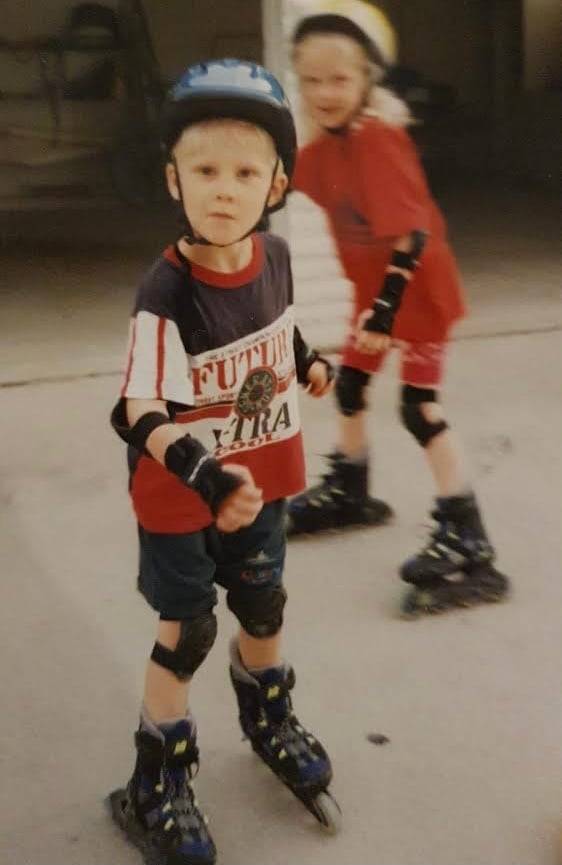
Blues defenseman Niko Mikkola rollerblades with his sister, Nina. (Photo: Nina Linnainmaa.)
And if it wasn’t hockey, it was some other competition: soccer, baseball, skiing or orienteering, which combines hiking and navigational skills.
“We used to compete a lot. And it didn’t matter where, we competed,” Linnainmaa says. “Our parents would sometimes play a trick on us and say, ‘Run around the yard, and we will take time.’ They didn’t take time. They were just telling us, ‘OK that was a bit faster than last time. Please try again.’ That was their way (to get rid of us).”
Asked who won those races, Mikkola doesn’t hesitate in responding. “Me.”
Linnainmaa jokes, however, that her younger brother has never won a fight between the siblings. She let that slip in an interview with a Finnish gossip newspaper a few years ago.
“That became like a headline, like shocking news: ‘Niko has not won against his sister on a fight,’” she says. “He was embarrassed.”
Mikkola didn’t find out what his sister had said until he read it in the article.
“I was laughing first, and then I call her,” he says. “I say, ‘Don’t say that again.’ She was laughing.”
So is it true?
“I don’t know,” Mikkola says.
“Yes,” Linnainmaa says. “I was three years older, and Niko moved away when he was 15, so …”
In 2012, Mikkola left Kiiminki to play for the U18 team of the Finnish Elite League’s KalPa, which is located in Kuopio, about 3 1/2 hours away from his home. He would be living on his own, which he admitted was “a little bit scary.” But his parents would visit and bring him food, and Linnainmaa wasn’t worried. Her brother had always been independent. When he was little, he would pack his own hockey bag, making sure he had his helmet, skates, etc.
“It’s not just something he learned,” she says. “It’s something he’s always been.”
Mikkola played just 12 games in his first season for KalPa but suited up in 46 his second year and finished with four goals and 17 points.
“It was kind of like a fresh start,” he says. “I did get more ice time on that team, so I feel like that was good for me for sure.”
Meanwhile, the defenseman was sprouting. His dad is 6-foot-1 and both his mom and sister are 5-9, but Mikkola was well on his way to towering over all. In 2014, the year before he would be eligible for the NHL Draft the first time, he grew three inches.
“Niko was in Kuopio, and I was busy with my university studies, so living in different cities, I didn’t see him often,” Linnainmaa says. “It was like an instant that he became so tall.”
But despite his game developing and his frame extending, Mikkola, not unsurprisingly, went undrafted.
Timo Koskela, a former Blues area scout in Finland, was in his first year with the team when he spotted Mikkola.
“He caught our eye the year he went through the draft, but in the second year, his game really improved,” Koskela says. “But he was a late bloomer, a little bit, over here. He was a lanky kid, but every time when I saw him, the two things that caught my eye: He really wanted to make a difference and his ability to skate as a big man.”
In Mikkola’s third season with KalPa, 2014-15, he had nine goals and 23 points in 37 games on the U20 team and also made his first appearance in the Finnish Elite League. But still, when Central Scouting released its mid-term rankings of European skaters in January, he was not among the 210 on the list, and when the final rankings came out in early April, he was No. 111.
The Blues thought at the time they might be able to get Mikkola in the sixth or seventh round of the 2015 draft. But that changed when Koskela watched him at an international tournament in April, two months before the draft.
“He played really well at the end of the season, and I was nervous because there was a lot of scouts (at the tournament),” Koskela says. “I kind of thought that he wasn’t (a secret) anymore.”
Two years earlier, the Blues had made a trade with New Jersey, sending forward Matt D’Agostini to the Devils for a conditional 2015 seventh-round pick. The condition was if D’Agostini was not re-signed by New Jersey, the selection would become a fifth-rounder.
D’Agostini was not re-signed, therefore the Blues got pick No. 127 from the Devils.
“I remember we were discussing closely, like, ‘What would be the right time to take him?’” Koskela says. “We had a pick early in the fifth round, and we thought that’s the place where we can get this guy.”
Then Koskela had an idea. A day or two before flying to the U.S. for the draft, which was held in Sunrise, Fla., that year, he would drive to Kuopio to meet Mikkola in person.
“I wanted to get an idea of how many teams interviewed him,” Koskela says. “I waited a long time to be the last one who could interview him before the draft, so that’s why I drove and tried to get all the possible information. But you know, Niko was smart. He said he had some interviews.”
Mikkola says he wasn’t fibbing when he told Koskela that he had spoken with 10 to 15 NHL clubs.
Either way, the Blues knew if they wanted him, they had to grab him sooner than later.
“He was late on to our list,” says Bill Armstrong, the club’s ex-director of amateur scouting, who drafted Mikkola. “Timo kept talking about the kid, and then he played well in the late tournament. We went to go see him at the end of the year, and everybody just came away excited about him. You’ve got to give a lot of credit to the area scout for really going to town on him and getting him on the board.”
That year, the Blues took Vince Dunn in the second round, followed by forwards Adam Musil and Glenn Gawdin in the fourth.
“As the head scout, at that point, you’re looking for something of a quality,” Bill Armstrong says. “I’ll give you an example: So, OK, a guy has 110 points in junior, but he has no size and he’s just playing with somebody good, so his game is not going to translate. … He might be a great junior player, a great college player, a great European player, but you want to see NHL qualities so you can sink your teeth in and say, ‘This is why we’re taking this guy.’ With Mikkola, we could sink our teeth into the quality of his size, his compete and his ability on the defensive side of the puck.”
So after Carolina made its pick at No. 126, the Blues took him. Mikkola actually thought the fifth round is about where he’d go, and because typically only players who are projected to go in the first few rounds attend the draft, he was not in Florida.
“No, no, no. He was in the sauna somewhere in Finland,” Bill Armstrong says.
Actually, with Rounds 2-7 taking place in the afternoon, Mikkola was out for dinner with some friends when his agent called to tell him the news.
“I think I was like one step closer,” he says.
Before he became the Blues’ GM, Doug Armstrong worked in Dallas under Bob Gainey, and one of the many lessons he learned from the Hall of Famer applied in the decision to keep Mikkola playing in Finland after he was drafted.
“The feeling was: Until you can play in the World Championships, there’s enough you can develop over there,” Armstrong says. “A lot of organizations see it totally different. They want to get them over to North America as quickly as possible. I personally have no problem leaving a European there until (age) 22-23 and let them just develop in a very comfortable environment.”
Mikkola agreed with the decision.
“I wasn’t ready for the NHL back then, but I was growing up as a player,” he says. “There’s no rush to get there if you’re not ready. So I stayed for a couple of years. I think that was good for me, growing up as a player. … I found more of my game, like my style.”
Growing up, Mikkola had watched skilled Finnish defensemen Teppo Numminen and Kimmo Timonen, along with the likes of Janne Niinimaa and Joni Pitkanen. But he modeled his game more as a sturdy blueliner who liked to defend.
“He has a big frame, and since I’ve known him and played against him, he’s always been willing to go in and battle and lay the body on people,” says Jani Hakanpaa, a Ducks defenseman who played with and against Mikkola in Finland and trains with him in the offseason. “He knows how good he is, and that’s one thing that keeps him going. He always wants to challenge himself and be in your grill out there. He always wants to win and be the best guy out there.”
Koskela remembers a story that demonstrates Mikkola’s competitiveness. It was Mikkola’s second full season playing in the Elite League, and he was eyeing a more prominent role on the team.
“The coach (Pekka Virta) told me that he interviewed Niko and he asked, ‘What’s your goal for the upcoming season?’ and Niko told him, ‘To play in the top six,’” Koskela says. “They had a really good D that year, and the coach told him, ‘OK, this is the list. Who is the guy that you are going to push out from the lineup?’ Niko’s answer was, ‘That’s your problem, but I’m going to be one of those six who’s going to play.’ And he did it.”
“Just be confident and trust myself,” Mikkola says. “I knew I’m going to take that spot on the team. Yeah, I took that top-six spot.”
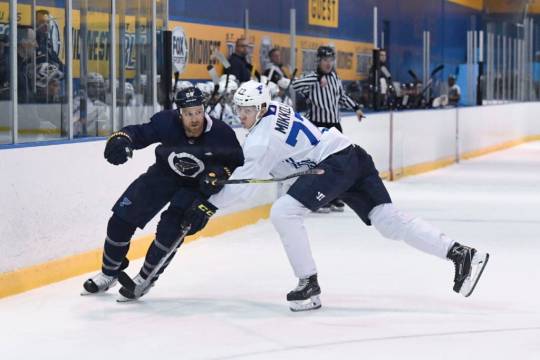
Niko Mikkola participates in a Blues’ camp in 2017. (Photo: Scott Rovak / St. Louis Blues.)
The Blues would get glimpses of Mikkola’s ability when he visited St. Louis for development camps, rookie tournaments and one training camp.
“The first thing you notice is his size,” Doug Armstrong says. “He’s got great reach, good size. And then you watch him play, and he’s competitive. He was raw at that time, but he is a very competitive person. You either have that or you don’t have that, and he had that right from the get-go.”
For the first time, Mikkola was measuring himself against future NHL players.
“I felt pretty good at that time,” he says. “I just knew that it was my goal to get here someday.”
After one final season in Finland, Mikkola came to North America in 2018-19, making the transition to a new country, new language and smaller rink in San Antonio, Texas, where the Blues’ AHL affiliate played at the time.
Everything translated.
In 70 games, Mikkola had just two goals and nine points, but his defensive play was impressive.
“You don’t have that much time on the puck, so that was the thing maybe took a little time, to move the puck quicker than back in Finland,” he says. “The Blues said that, and I felt that myself. But it was getting better.”
Doug Armstrong remembers the minor-league reports on Mikkola.
“It just re-enforced what you saw his first time: that high level of competitiveness — sort of a North American stature to his game,” he says. “He was willing to play on the edge. He fought. He did the things that aren’t common in European hockey. Then the rougher edges started to get smoothed out. His passing became accurate, quicker, harder. His reading the first play was becoming natural to him and just keeping the game in front of him.”
The World Championship was in Slovakia the next season, and when Jere Lehtinen, a former NHL player who is Finland’s national team GM, reached out to Armstrong. The two were in Dallas together.
“Jere said, ‘We don’t really have him on our radar screen,’ and I just said, ‘Well, he’s played really good in the American League this year,’” Armstrong recalls. “So they brought him in, but he had to go there not knowing if he was going to make the team.”
Jukka Jalonen, the coach of the national team that year, already knew Mikkola, having coached him in 2015 at a U20 international tournament.
“He made an impression for me, but back then, he didn’t have great puck skills,” Jalonen says. “He wasn’t that major, to be honest with you, because he was a younger guy. (But) we hadn’t seen him so much lately because he had played for AHL team. I thought we will need size on our roster in the World Championships. (Lehtinen) was also very positive watching him play on TV from videos.
“When he came in, right away we noticed that he will make the team.”
The configuration of the World Championship lineup is a little bit different because teams play as many as 10 games in 17 days, so they dress eight defensemen. Mikkola was in the second pair, logging about 14 to 16 minutes per game, which included time on the penalty kill.
In that tournament, which features many NHL players whose clubs aren’t in the playoffs, Finland ran into some serious offensive talent. Sweden, whom the Finns edged 5-4 in overtime in the quarterfinals, had Vancouver’s Elias Pettersson and Toronto’s William Nylander.
“I remember that first faceoff in overtime,” Mikkola says. “It was like Nylander, Pettersson and like (Oliver) Ekman-Larsson. Yeah, I was like, ‘Oh fuck. I have to skate hard.’ But it went pretty well.”
Finland advanced to play Russia, which had Washington’s Alex Ovechkin and Evgeny Kuznetsov and Pittsburgh’s Evgeni Malkin, in the semifinals, and blanked them, 1-0.
“Just looking back at the last minutes of the game, (Mikkola) did a good job of handling them,” says Hakanpaa, who was also on the team. “He doesn’t care who’s coming at him, if it’s Ovechkin or Malkin.”
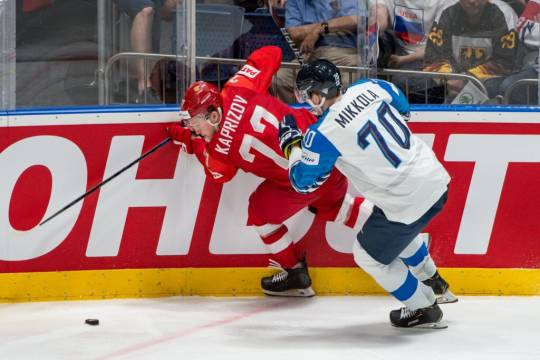
Niko Mikkola defends fellow NHL rookie Kirill Kaprizov at the World Championship in 2019. (Photo: Robert Hradil / Getty Images.)
Finland won the gold-medal game 3-1 over Canada, which was led by Vegas’ Mark Stone and Philadelphia’s Sean Couturier.
Mikkola finished the tournament with two goals and five points in 10 games and was a plus-3.
“He did exactly what we wanted or imagined,” Jalonen says. “He didn’t play the power play, but still he had five points, which was very good. … I remember him defending against very good NHL players. He’s a little bit like a horse. He’s in very good physical condition, and he battled all night long.”
“I played pretty good,” Mikkola says. “It was kind of a breakout, for sure.”
Back in San Antonio in December 2019, Mikkola was anticipating a visit from Linnainmaa and her boyfriend (now husband), spending a few days together for Christmas. But with the couple’s flight laying over in Chicago, Mikkola was called up by the Blues. So they rented a car and made the five-hour drive to St. Louis.
“We wanted to make sure that when we were in the United States, we will get to see Niko at whatever costs,” Linnainmaa says.
Unfortunately, Mikkola didn’t play that night, but he did skate in the warmups.
“We made these really big placards, saying, ‘Niko’ and ‘Mikkola,’” Linnainmaa says. “There were like three times that the security personnel were stopping us saying, ‘Why do you have those kind of fan posters?’ They were OK because they were only ‘Niko Mikkola.’ So we went to really near the ice hockey rink, hanging our cards there. I think that I got noticed by the team.”
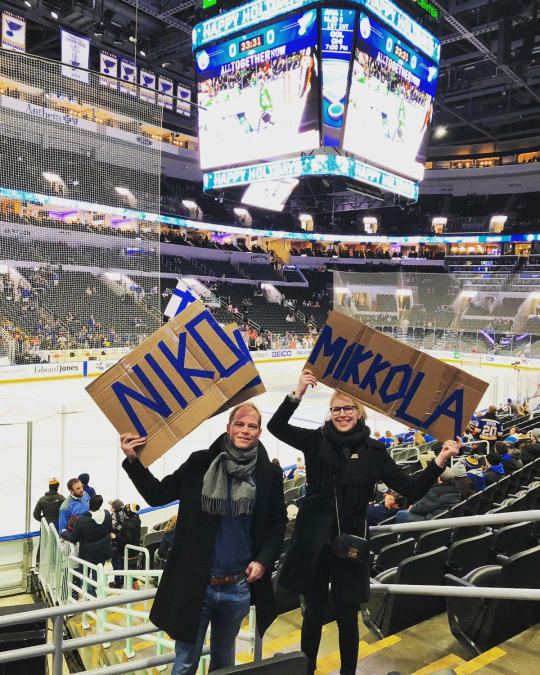
Nina Linnainmaa and her boyfriend show support for Linnainmaa’s younger brother, Blues defenseman Niko Mikkola. (Photo: Nina Linnainmaa)
Mikkola, who beforehand begged them not to embarrass him, doesn’t believe any players saw it.
“But our equipment guy noticed and asked me if I had family here,” he says. “I was like, ‘Yeah, my sister and her boyfriend.”
Shortly after, Mikkola was re-assigned to San Antonio, and they got their holiday time.
His sister had returned to Finland by the time he was recalled again and made his NHL debut against the Sharks on Jan. 6, 2020.
“The first game, we had to watch. That was huge!” Linnainmaa says. “Niko texted us that he will play on that night. So, yeah, we spent 30 Euros ($35) to get to see the game. I think he was excited, but sometimes it’s hard to tell because he doesn’t like scream or anything. He just says, ‘OK, I will play tonight in my first NHL game.’ You know he’s excited, but he’s really casual.”
“I know it’s a big deal, and those are big moments,” Mikkola says. “For sure I was a little bit nervous, but that was a very exciting day.”
He remained on the Blues’ roster for five games, averaging 14:22 of ice time. He was impressive enough that two weeks later the team signed him to a two-year, $1.6 million contract. It’s a one-way deal, meaning he’ll be paid an NHL salary even if he’s assigned to the minors.
“I give him credit. We’ve obviously given him a one-way contract because we think he can play in the league,” Doug Armstrong says. “When he’s in there, he’s proven he can play in the league. It’s just a matter of a consistent opportunity.”
In 16 games this season, Mikkola is averaging 13:17 of ice time, and that elusive first goal came Monday.
“He’s done a great job of kind of doing what’s been asked of him,” Blues defenseman Justin Faulk says. “He’s open to everything. He listens. He works hard. And as a young guy, if you continue to do that, it generally makes your job a bit easier. You start to settle in and get more comfortable. He hasn’t played a ton of games, but he’s going to have an opportunity here to kind of cement his spot in the lineup and show what he can do. We all think he’s capable of kind of taking the reins and stepping up.”
In addition to now being a regular in the NHL, Jalonen says, “I’m sure he’ll be fighting for a spot on the national team for the (2021) Olympics. He has a chance to be involved, for sure.”
Linnainmaa can’t fathom the opportunities her brother is creating for himself.
“It’s hard to believe because there are so many people that dream of it,” she says. “But on the other hand, he has always been really hardworking and diligent and responsible person. So, in a way, he had the qualities to make it.”
“Niko has done the work,” Koskela says. “I was the first guy who saw him play, but keep the credit for Niko.”
Don’t talk about credit with Mikkola, though.
“I don’t think about it like ‘I made it,’” he says. “I’m still on the way, and there’s still things I want to do to be better.”
And whenever his hockey career ends, there will always be an opportunity to drive the garbage truck.
“Yeah, usually you don’t play ice hockey when you’re 60, so you still have some good years after the career,” Linnainmaa says.
“He can do that when he’s retired from the first part,” Doug Armstrong adds.
“That’s true,” Mikkola says.
-
The Athletic | 3.10.21 (x)
#niko mikkola#florida panthers#its a phenomenal athletic article go read it 👍#you get a lot of embarrassing mikksy stories and a good semblance of this goofs personality if you arent already familiar#very charming it made me cry tears of hysterics#and also cute baby mikksy pictures!#it was written in 2021 so its been 3 years but its still very revelant#mikksy lore is so important#i think the idea that for 4 yr old mikksy the career path being either hockey or garbage truck driver is something so special#also mikksy apparently being in denial about his sister embarrassing him for umpteenth time is so#this is just mikksys older sister tortures him for multiple paragraphs: the article#also him going against willy petey and oel in the ihwc in '19 and going “fuck i need to skate hard” KILLS ME EVERYTIME LIKE MIKKSY 😭😭😭#EVERYONE not letting mikksy live down his garbageman dreams and going when you retire you can always drive the garbage truck#and him going thats true#hes so fucking funny
6 notes
·
View notes